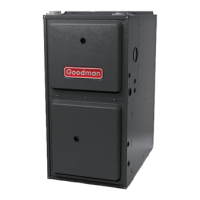27
4. Consult the proper tables for the quantity of air.
If the total external static pressure exceeds the maximum
listed on the furnace rating plate, check for closed
dampers, registers, undersized and/or oversized poorly laid
out duct work.
The bottom return air opening on upow models utilizes
a “lance and cut” method to remove sheet metal from the
duct opening in the base pan. To remove, simply press
out the lanced sections by hand to expose the metal strips
retaining the sheet metal over the duct opening. Using
tin snips, cut the metal strips and remove the sheet metal
covering the duct opening. In the corners of the opening,
cut the sheet metal along the scribe lines to free the duct
anges. Using the scribe line along the duct ange as a
guide, unfold the duct anges around the perimeter of the
opening using a pair of seamer pliers or seamer tongs.
.
When the furnace is used in connection with a cooling unit,
the furnace should be installed in parallel with or on the
upstream side of the cooling unit to avoid condensa tion
in the heating element. With a parallel ow arrange ment,
the dampers or other means used to control the ow of
air must be adequate to prevent chilled air from entering
the furnace and, if manually operated, must be equipped
with means to prevent operation of either unit unless the
damper is in the full heat or cool position.
WARNING
Refer to your furnace rating plate for the maximum ESP
(external duct static) rating.
Total external static refers to everything external to the
furnace cabinet. Cooling coils, lters, ducts, grilles,
registers must all be considered when reading your total
external static pressure. The supply duct pressure must be
read between the furnace and the cooling coil. This reading
is usually taken by removing the “A” shaped block o
plate from the end on the coil; drilling a test hole in it and
reinstalling the block o plate. Take a duct static reading
at the test hole. Tape up the test hole after your test is
complete. The negative pressure must be read between
the lter and the furnace blower.
Too much external static pressure will result in insucient
air that can cause excessive temperature rise. This can
cause limit switch tripping and heat exchanger failure.
To determine total external duct static pressure, proceed as
follows;
1. With clean lters in the furnace, use a draft gauge
(inclined manometer) to measure the static pressure
of the return duct at the inlet of the furnace. (Negative
Pressure)
2. Measure the static pressure of the supply duct.
(Positive Pressure)
3. The dierence between the two numbers is .4” w.c.
For example:
-.1 0 .1 .2 .3
Difference is .4
.
.
Static reading from return duct = -.1” w.c.
Static reading from supply duct = .3” w.c.
Total external static pressure on this system =.4” w.c.

